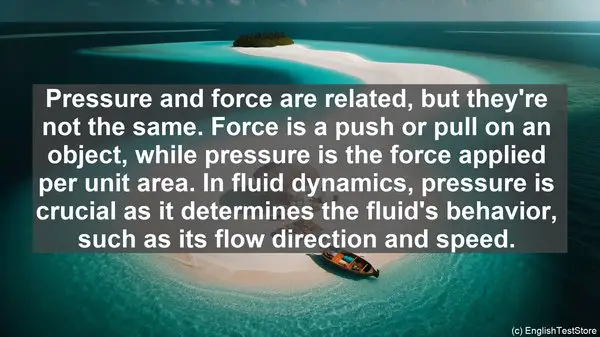Introduction to Fluid Dynamics
Welcome to our fluid dynamics series. Today, we’re going to dive into the world of commonly confused words. Understanding these terms is crucial for any student studying fluid dynamics. So, let’s get started!
1. Viscosity vs. Velocity
Viscosity and velocity are two terms that are often used interchangeably, but they have distinct meanings. Viscosity refers to a fluid’s resistance to flow, while velocity is the speed at which the fluid is moving. So, while viscosity determines how easily a fluid flows, velocity tells us how fast it’s flowing.

2. Pressure vs. Force
Pressure and force are related, but they’re not the same. Force is a push or pull on an object, while pressure is the force applied per unit area. In fluid dynamics, pressure is crucial as it determines the fluid’s behavior, such as its flow direction and speed.
3. Compressible vs. Incompressible
When it comes to fluid behavior, compressibility plays a significant role. Compressible fluids, like gases, can be easily compressed, meaning their density can change. Incompressible fluids, on the other hand, like liquids, have a constant density and cannot be compressed. This distinction is vital in various fluid dynamics applications.
4. Streamline vs. Turbulent Flow
Fluid flow can be categorized into two types: streamline and turbulent. Streamline flow is smooth, with well-defined paths, while turbulent flow is chaotic, with eddies and swirls. Understanding the type of flow is essential, as it affects factors like drag and heat transfer in fluid systems.
5. Bernoulli’s Principle vs. Continuity Equation
Bernoulli’s principle and the continuity equation are both fundamental in fluid dynamics, but they address different aspects. Bernoulli’s principle relates to the conservation of energy in a fluid, stating that as the fluid’s speed increases, its pressure decreases. The continuity equation, on the other hand, deals with the conservation of mass in a fluid, stating that the mass flow rate is constant in a closed system.
6. Laminar vs. Turbulent Boundary Layer
The boundary layer is the thin layer of fluid adjacent to a solid surface. In laminar flow, this layer is smooth and well-ordered, while in turbulent flow, it’s chaotic. The type of boundary layer affects factors like drag and heat transfer, making it crucial to consider in various fluid dynamics applications.
7. Subsonic vs. Supersonic
When it comes to fluid flow, the speed of the fluid relative to the speed of sound is significant. Subsonic flow is when the fluid’s speed is lower than the speed of sound, while supersonic flow is when it’s higher. The behavior of the fluid, including factors like shock waves, changes depending on whether it’s subsonic or supersonic.

8. Cavitation vs. Boiling
Cavitation and boiling are both related to the formation of vapor bubbles in a fluid, but they occur under different conditions. Cavitation happens when the fluid’s pressure drops below its vapor pressure, leading to the formation of vapor bubbles. Boiling, on the other hand, occurs when the fluid is heated to its boiling point, causing rapid vaporization. Both phenomena can have significant effects on fluid systems.
9. Reynolds Number vs. Mach Number
Reynolds number and Mach number are both dimensionless quantities used in fluid dynamics, but they represent different characteristics. Reynolds number relates to the flow regime, indicating whether it’s laminar or turbulent. Mach number, on the other hand, represents the fluid’s speed relative to the speed of sound. Both numbers provide valuable information about the fluid’s behavior.
10. Hydrostatic Pressure vs. Dynamic Pressure
In fluid systems, pressure can be categorized into hydrostatic and dynamic pressure. Hydrostatic pressure is the pressure exerted by a fluid at rest, while dynamic pressure is the pressure exerted by a fluid in motion. Understanding these pressure types is crucial for analyzing fluid behavior in various scenarios.
